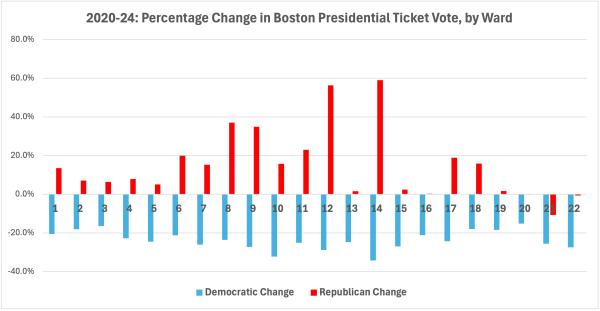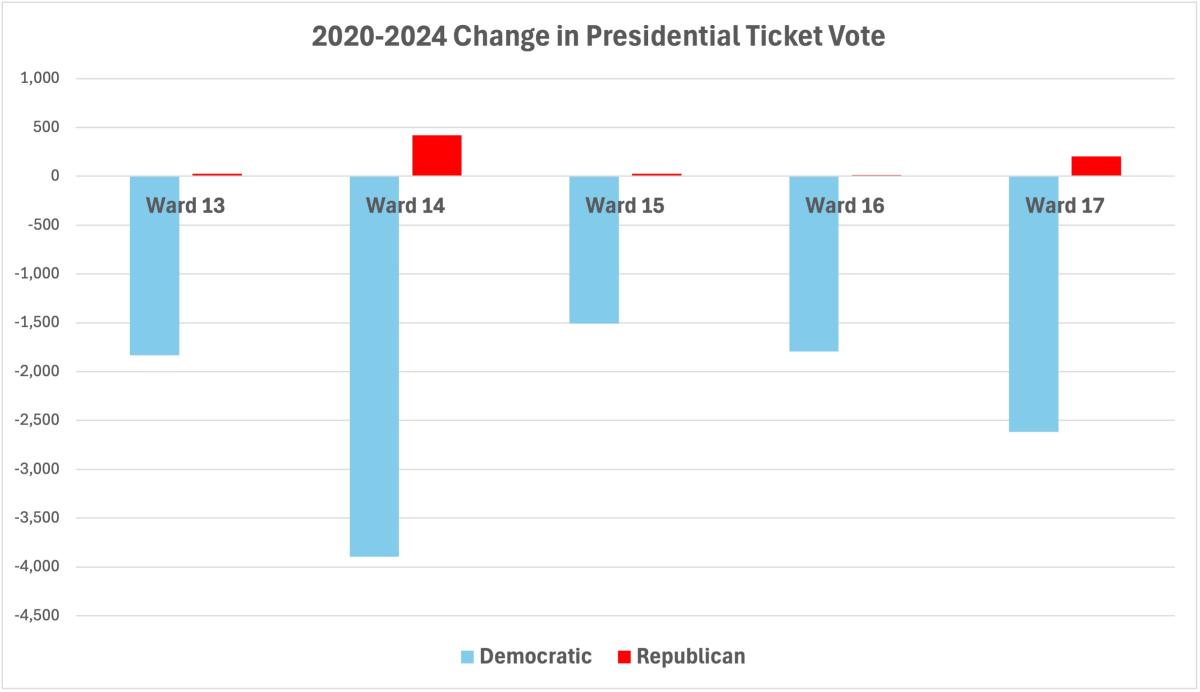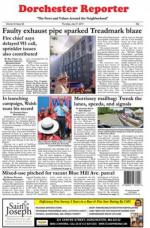November 12, 2024

This chart illustrates the percentage change in the presidential ticket vote by Boston ward between 2020 and 2024. Reporter graphic by Chris Lovett
In 17 of Boston’s 22 wards, the 2024 vote for the Democratic presidential ticket was down by more than 20 percent.
The 2024 election results show that Boston remains a Democratic stronghold, but this time with a noticeable downturn in support for the party’s presidential ticket and the overall level of voter engagement. It was less about a Donald Trump surge than negative voltage for the Democratic presidential ticket, with thousands of voters unplugged.
While national results gave the former president a second term in the White House, he increased his showing in Boston to 20.2 percent of the vote, up from 15.4 percent in 2020 and 13.7 percent in 2016. The citywide count for Trump and running mate JD Vance increased from the 2020 total for Trump and Mike Pence by 4,229 votes or 9.3 percent.
But gains for the Republican ticket in 2024 were much smaller than losses for Vice President Kamala Harris and Tim Walz, whose total in Boston fell short of the 2020 vote count for the Democratic presidential ticket by 55,298 votes, or 22.8 percent.
In Dorchester’s Wards 13-17, the pattern was similar. Trump increased his count here by 682 votes (15.8 percent), while Harris, compared with 2020 results for her and President Joe Biden, fell short by 11,649 votes (25.6 percent), more than 17 times the gain for Trump.

The numbers of votes cast were down by double digits in all five Dorchester wards, with the smallest drop in Ward 16 (Fields Corner to Neponset Circle, east of Dorchester Avenue), by 14.2 percent, and the largest in Ward 14 (from Grove Hall and Four Corners to Franklin Field and part of Mattapan north of Walk Hill Street), by 28.2 percent.
The largest slippage for the Democratic presidential ticket in Dorchester was in Ward 14, with the 2024 total for the Democratic ticket down by 3,895 votes or 34.2 percent. The smallest drop was in Ward 16, by 1,796 votes (21.1 percent). Trump got only 11 more votes this year in Ward 16, but that was enough—combined with Democratic slippage—to help him flip two areas carried by his rivals in 2020: Precinct 9 (east of Adams Street, from Ashmont Street to Gallivan Boulevard) and Precinct 12 (near Keystone Apartments and Florian Hall).
In Ward 13’s perennially high-turnout Precinct 10 (Savin Hill), Trump improved his 2020 count by only three votes, but the tally for the Democratic ticket was down from 2020 by 164 votes (16 percent). One outlier was Ward 16’s Precinct 8 (west of Adams Street, from Ashmont Street to Gallivan Boulevard), where totals were up for presidential tickets in both parties, with Harris and Walz getting about two-thirds of the vote.
This year’s results from Boston also depart from a trend of steadily rising numbers of votes in presidential election years, going back at least two decades. Even though Boston’s voter enrollment figure was slightly higher than it was in 2020, the number of votes cast in this year’s election was down by more than 50,000, or 17 percent.
In Ward 20 (West Roxbury and part of Roslindale), with consistently high turnouts, the number of votes for Trump even declined slightly (0.2 percent) from 2020, but the tally for Harris/Walz was down from the figure for Biden/Harris by 2,646 votes, or 15.2 percent. The drop for Harris/Walz was even greater in the more populous and racially mixed Ward 18 (Hyde Park, parts of Mattapan and Roslindale), by 4,656 votes, or 18 percent.
In terms of percentages—if with smaller voting bases, the gains for Trump were most dramatic in Roxbury’s Ward 12 and Dorchester’s Ward 14, where the increases were by more than 50 percent (above a small base), surpassing the percentage drops for Harris/Walz (with a much larger base). Trump also had gains of more than 20 percent in Wards 8, 9, and 11, encompassing parts of Roxbury, the South End, and Jamaica Plain. Though long associated with Boston’s Black community, most of these areas are also home to increasing numbers of Latino voters—a constituency that yielded significant gains for Trump this year nationwide.
In Dorchester, the next highest gain for Trump was in Ward 17 (Codman Square-Lower Mills), but the difference from his 2020 total was 204 votes, less than one-tenth the drop for the Democratic ticket. The same trend was found in Wards 16, 15 (Fields Corner/Meeting House Hill) and 13 (Uphams Corner to Columbia-Savin Hill), with even smaller gains for Trump and much larger declines for the Democratic ticket. Even in Ward 14, the downturn for Democrats—by 3,895 votes—was almost ten times greater than the gain for Trump, with his additional 418 votes.
In 17 of Boston’s 22 wards, the 2024 vote for the Democratic presidential ticket was down by more than 20 percent. These include the Dorchester wards, but also South Boston (Wards 6 and 7), East Boston, Allston-Brighton (Wards 21 and 22), and wards covering the Back Bay and part of Beacon Hill, the Fenway, Mission Hill, and the rest of Roxbury, as well as parts of the South End. But, in Dorchester, the smallest percentage downturn for the Democratic ticket was in Ward 16, a more politically moderate area, with a higher percentage of white voters, despite support in two predominantly white precincts for Trump and Vance.
Figures from Allston-Brighton, the Fenway, and Mission Hill—areas with Boston’s highest college student population—show downturns for the Democratic ticket by more than 20 percent. These areas had a significant drop in the number of votes cast: by 19.1 percent in Ward 4 (mostly the Fenway), more than 22 percent in Wards 21 and 22, and 26.6 percent in Ward 10 (Mission Hill/Hyde Square).




